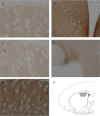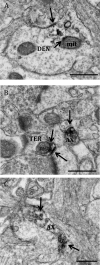Estrogen receptors are found in glia and at extranuclear neuronal sites in the dorsal striatum of female rats: evidence for cholinergic but not dopaminergic colocalization
- PMID: 22919059
- PMCID: PMC3473205
- DOI: 10.1210/en.2012-1458
Estrogen receptors are found in glia and at extranuclear neuronal sites in the dorsal striatum of female rats: evidence for cholinergic but not dopaminergic colocalization
Abstract
Estrogens rapidly affect dopamine (DA) neurotransmission in the dorsal striatum (dSTR) and DA-related diseases, such as Parkinson's disease and schizophrenia. How estrogens influence DA function remains unclear, in part, because the ultrastructural localization of estrogen receptors (ER) in the dSTR is not known. Light microscopic studies of the dSTR have suggested the presence of ER. This experiment used electron microscopy to determine whether these ER are at extranuclear sites in the dSTR, providing evidence for a mechanism through which estrogen could rapidly affect DA transmission. The dSTR was labeled with antibodies for ERα, ERβ, and G protein-coupled ER 1 (GPER-1) to confirm whether these ER were present in this brain area. After this, the dSTR was dual labeled with antibodies for ERα or GPER-1 and tyrosine hydroxylase or vesicular acetylcholine transporter to determine whether ER are localized to dopaminergic and/or cholinergic processes, respectively. Ultrastructural analysis revealed immunoreactivity (IR) for ERα, ERβ, and GPER-1 exclusively at extranuclear sites throughout the dSTR. ERα-, ERβ-, and GPER-1-IR are mostly frequently observed in axons and glial profiles but are also localized to other neuronal profiles. Dual labeling revealed that ERα- and GPER-1-IR is not associated with DA axons and terminals but is sometimes associated with cholinergic neurons. Because these receptors are exclusively extranuclear in the dSTR, binding at these receptors likely affects neurotransmission via nongenomic mechanisms.
Figures






Similar articles
-
Estrogen receptors observed at extranuclear neuronal sites and in glia in the nucleus accumbens core and shell of the female rat: Evidence for localization to catecholaminergic and GABAergic neurons.J Comp Neurol. 2022 Aug;530(11):2056-2072. doi: 10.1002/cne.25320. Epub 2022 Apr 9. J Comp Neurol. 2022. PMID: 35397175 Free PMC article.
-
Subcellular relationships between cholinergic terminals and estrogen receptor-alpha in the dorsal hippocampus.J Comp Neurol. 2003 Sep 1;463(4):390-401. doi: 10.1002/cne.10753. J Comp Neurol. 2003. PMID: 12836175
-
Estrogen receptor α and G-protein coupled estrogen receptor 1 are localized to GABAergic neurons in the dorsal striatum.Neurosci Lett. 2016 May 27;622:118-23. doi: 10.1016/j.neulet.2016.04.023. Epub 2016 Apr 11. Neurosci Lett. 2016. PMID: 27080432 Free PMC article.
-
Sex and estradiol effects in the rodent dorsal striatum.Eur J Neurosci. 2024 Dec;60(12):6962-6986. doi: 10.1111/ejn.16607. Epub 2024 Nov 21. Eur J Neurosci. 2024. PMID: 39573926 Free PMC article. Review.
-
Cholinergic axon terminals in the ventral tegmental area target a subpopulation of neurons expressing low levels of the dopamine transporter.J Comp Neurol. 1999 Jul 26;410(2):197-210. doi: 10.1002/(sici)1096-9861(19990726)410:2<197::aid-cne3>3.0.co;2-d. J Comp Neurol. 1999. PMID: 10414527 Review.
Cited by
-
Dose-dependent effects of estrogen on prediction error related neural activity in the nucleus accumbens of healthy young women.Psychopharmacology (Berl). 2020 Mar;237(3):745-755. doi: 10.1007/s00213-019-05409-7. Epub 2019 Nov 26. Psychopharmacology (Berl). 2020. PMID: 31773208 Clinical Trial.
-
The G-protein coupled estrogen receptor (GPER/GPR30) is a gonadotropin receptor dependent positive prognosticator in ovarian carcinoma patients.PLoS One. 2013 Aug 9;8(8):e71791. doi: 10.1371/journal.pone.0071791. eCollection 2013. PLoS One. 2013. PMID: 23951246 Free PMC article.
-
Estradiol rapidly modulates excitatory synapse properties in a sex- and region-specific manner in rat nucleus accumbens core and caudate-putamen.J Neurophysiol. 2019 Sep 1;122(3):1213-1225. doi: 10.1152/jn.00264.2019. Epub 2019 Jul 17. J Neurophysiol. 2019. PMID: 31314648 Free PMC article.
-
Interactions between estrogen receptors and metabotropic glutamate receptors and their impact on drug addiction in females.Horm Behav. 2018 Aug;104:130-137. doi: 10.1016/j.yhbeh.2018.03.001. Epub 2018 Mar 10. Horm Behav. 2018. PMID: 29505763 Free PMC article. Review.
-
Age and Long-Term Hormone Treatment Effects on the Ultrastructural Morphology of the Median Eminence of Female Rhesus Macaques.Neuroendocrinology. 2016;103(6):650-64. doi: 10.1159/000442015. Epub 2015 Nov 5. Neuroendocrinology. 2016. PMID: 26536204 Free PMC article.
References
-
- Quinlan MG, Hussain D, Brake WG. 2008. Use of cognitive strategies in rats: the role of estradiol and its interaction with dopamine. Horm Behav 53:185–191 - PubMed
-
- Nofrey BS, Ben-Shahar OM, Brake WG. 2008. Estrogen abolishes latent inhibition in ovariectomized female rats. Brain Cogn 66:156–160 - PubMed
-
- Quinlan MG, Duncan A, Loiselle C, Graffe N, Brake WG. 2010. Latent inhibition is affected by phase of estrous cycle in female rats. Brain Cogn 74:244–248 - PubMed
-
- Bourque M, Dluzen DE, Di Paolo T. 2009. Neuroprotective actions of sex steroids in Parkinson's disease. Front Neuroendocrinol 30:142–157 - PubMed
Publication types
MeSH terms
Substances
Grants and funding
LinkOut - more resources
Full Text Sources
Molecular Biology Databases

